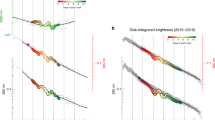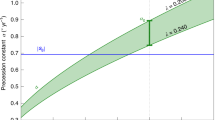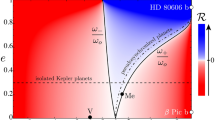Abstract
NOTWITHSTANDING his comparatively small diameter and slow axial motion, the planet Mars affords special facilities for the exact determination of the rotation period. Indeed no other planet appears to be so favourably circumstanced in this respect, for the chief markings on Mars have been perceptible with the same definiteness of outline and characteristics of form through many succeeding generations, whereas the features such as we discern on the other planets are either temporary atmospheric phenomena or rendered so indistinct by unfavourable conditions as to defy lengthened observation. Moreover it may be taken for granted that the features of Mars are permanent objects on the actual surface of the planet, whereas the markings displayed by our telescopes on some of the other planetary members of our system are mere effects of atmospheric changes which, though visible for several years and showing well-defined periods of rotation, cannot be accepted as affording the true periods. The behaviour of the red spot on Jupiter may closely intimate the actual motion of the sphere of that planet, but markings of such variable unstable character can hardly exhibit an exact conformity of motion with the surface upon which they are seen to be projected. With respect to Mars the case is entirely different. No substantial changes in the most conspicuous features have been detected since they were first confronted with telescopic power, and we do not anticipate that in future ages there will be any material difference in their general configurations. The same markings which were indistinctly revealed to the eyes of Fontana and Huyghens in 1636 and 1659, will continue to be displayed to the astronomers of succeeding generations, though with greater fulness and perspicuity owing to improved means. True there may possibly be variations in progress as regards some of the minor features, for it has been suggested that the visibility of certain spots have varied in a manner which cannot be satisfactorily accounted for on ordinary grounds. These may possibly be due to atmospheric effects on the planet itself, but in many cases the alleged variations have doubtless been more imaginary than real. The changes in our own climate are so rapid and striking, and occasion such abnormal appearances in celestial objects that we are frequently led to infer actual changes where none have taken place; in fact, observers cannot be too careful to consider the origin of such differences and to look nearer home for some of the discordances which may have become apparent in their results.
This is a preview of subscription content, access via your institution
Access options
Subscribe to this journal
Receive 51 print issues and online access
$199.00 per year
only $3.90 per issue
Buy this article
- Purchase on Springer Link
- Instant access to full article PDF
Prices may be subject to local taxes which are calculated during checkout
Similar content being viewed by others
Rights and permissions
About this article
Cite this article
DENNING, W. The Rotation Period of Mars. Nature 30, 55–56 (1884). https://doi.org/10.1038/030055c0
Issue Date:
DOI: https://doi.org/10.1038/030055c0
Comments
By submitting a comment you agree to abide by our Terms and Community Guidelines. If you find something abusive or that does not comply with our terms or guidelines please flag it as inappropriate.



